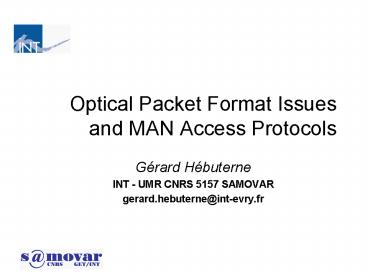Optical Packet Format Issues and MAN Access Protocols PowerPoint PPT Presentation
1 / 33
Title: Optical Packet Format Issues and MAN Access Protocols
1
Optical Packet Format Issues and MAN Access
Protocols
- Gérard Hébuterne
- INT - UMR CNRS 5157 SAMOVAR
- gerard.hebuterne_at_int-evry.fr
2
Motivation
- Growth in bandwidth demand
- Optics already present
- Fibres, using WDM, offer Gbit/s
- Multiservices networks based upon processing of
packets - Why not all-optical packet switching?
3
However, all-optical packet switching raises
several issues
- Especially, no large-scale buffering available
- How to provide QoS, with small buffers, for
links carrying Gbit/s or Tbit/s ? - The spectral domain, a new paradigm to add to
traffic engineering methods - Specific behaviours
- Synchronization, buffers
4
Synchronization
- Absorb jitter encountered in fibres
Influence of temperature, etc.
Influence of Propagation
5
Optical buffers
- Electrical buffers
- the packet waits until available resource
- Optical buffers Fibre Delay Lines
- the packet waits for a fixed duration
duration FDL length
6
Optical buffers (2)
7
(A personal view of) The typical all-optical
architecture
- The MAN collects flows from LANs, to the core
network
8
Packet format the choices (1)
- Fixed-length packets (FLP)
- packets processed/forwarded one at a time
- all packets have the same length
9
Packet format the choices (2)
- Variable-length packets (VLP)
- packets processed/forwarded one at a time,
- packets have arbitrary length
10
Packet format the choices (3)
- Slotted Variable-length packets (SVLP)
- packets processed/forwarded in bursts
- packets occupy an arbitrary number of slots
Header
Packet n
Packet m
Packet
11
Packet format traffic-related issues
- FLP, VLP, SVLP ?
- Which length (or minimum / maximum)
- Same format in WAN and MAN ?
- The decision must be based upon traffic
arguments (and others!) - efficiency in terms of bw consumption
- efficiency in terms of processing time
12
Current length of Internet packets
In nb of packets
In nb of bits
Source http//www.caida.org/analysis/AIX/plen_his
t/
13
A few figures
- Target bandwidths 10 to 40 Gbit/s
- Packet format
- duration several (up to 10) µs
- Guard bands headers synchronisation 50 to
100 ns ? - At 10 Gbit/s,
- 40 bytes (minimum) 30 50 ns
- 1500 bytes Ethernet frame 1.2 to 1.5 µs
14
Where is the choice significant ?
- At the network interfaces
- Client packets (ATM, Ethernet, etc.) have to fit
into optical containers. - At the MAC level
- Performance of simple/fast mechanisms
- In the core network
- Priorities, deflection, etc.
- Hardware aspects
- Standardisation
15
The Network interface
- LO size of fixed length optical pckt
- MO max size variable-length optical pckt
- ME max size electrical pckt (e.g. Ethernet)
Fixed
Variable
MO gt ME
LO gt ME
LO lt ME
MO lt ME
Aggregation mandatory
Segmentation mandatory
Segm/Reass mandatory
Nothing to do!
Additional delays ? Bandwidth loss ?
16
Example aggregation
- Need of a time-out to upper limit the aggregation
delay
Packet arrival
Timeout! Packet sent
optical packet
17
Efficiency of aggregation
- Measured in delay and fill ratio
Packets wait until completion of the optical
packet or time-out fires
Optic
Electronic
10 Gbit/s
18
Aggregation
- Arriving packets are stored in the optical
container - As soon container full (i.e. the arriving packet
too large), send the container - If it takes too long, send the container
- (the time out begins at the container is created)
19
Analysis (no time-out)
- Xn the size of the container after n-th packet
- fn size of n-th packet
- K size of container
20
Efficiency of aggregation
Client flow 1 Gbit/s
Client flow 0.5 Gbit/s
21
Aggregation and delays
- Obviously, performance level (delay, efficiency)
depends on - the bitrate of the aggregated flow
- the length of the optical packet
- the time-out value
22
In the Core Network
- How to perform prioritization mechanisms related
with QoS provision ? - What about contention resolution in switching
stages ? - Importance of synchronization
23
Contention resolution
- Deflection routing, eulerian circuits ?
- Use of buffers (of limited size)
- Case of synchronized, FLPs QoS levels handled by
priorities - Non-synchronized or VLPs priority schemes
difficult to handle
24
MAN Access protocol
- Assume the simplest access protocol empty
slot protocol - Hopefully, if load level not too high, fairness
will not be an issue ? - If needed, however, a more sophisticated control
can be implemented - Then, how to compare FLP and VLP ?
25
With variable length packets
- Gaps may form on the ring, as the packets
progress - lowering the capacity effectively available
- increasing unfairness
26
A model for variable-length packet insertion
- The transmitter observes the fibre in order to
detect a gap longer than the packet to send
27
Model (contd)
- An equivalent model
- instead of waiting for a gap large enough, the
transmitter sends its packet, but interrupts it
as soon as a packet arrives on the fibre - ? Equivalent to the Preemptive repeat-identical
priority model !
28
To illustrate
29
Example
- 20 stations,
- ring _at_ 10 Gbit/s
- 500 Mbit/s per station
30
Concluding remarks
- Specificity of all-optical packet networking
- Also, uncertainty in the assumptions of any
traffic study - services actually offered
- distribution of electrical packet lengths
- real demand on different QoS levels
31
Concluding remarks (2)
- Packet format remains an important open issue,
esp. because a standardized format conditions
future developments - Different formats in access and core ?
- Other (traffic related) arguments to be developed
? - Etc.
32
Concluding remarks (3)
- Other ways are considered
- optical burst switching (kind of fast circuit)
- circuit switching in the core !
See, e.g. http//www.stanford.edu/nickm/talks/Op
enArch_2003.ppt
33
Thank you
- for your attention

